A ‘Living Memorial’ for All the Victims of 9/11
by Dennis Speed
September 2016
This article appears in the September 23, 2016 issue of Executive Intelligence Review and is re-published here with permission.
The whole objection, however, of the immorality of poetry rests upon a misconception of the manner in which poetry acts to produce the moral improvement of man. Ethical science arranges the elements which poetry has created, and propounds schemes and proposes examples of civil and domestic life: nor is it for want of admirable doctrines that men hate, and despise, and censure, and deceive, and subjugate one another. But poetry acts in another and diviner manner. It awakens and enlarges the mind itself by rendering it the receptacle of a thousand unapprehended combinations of thought.
—Percy Bysshe Shelley
“A Defence of Poetry”
 View full size EIRNS/Don Clark
The Schiller Institute Chorus performed Mozart’s Requiem, and sang Spirituals a capella in Manhattan, New York, Sept. 10, 2016 in a living memorial for victims of the 9/11 attacks. |
Sept. 20—The 3,000 people that participated in one or more of the “Living Memorial” concerts held in New York City Sept. 9-12, experienced Percy Shelley’s hypothesis first hand. The “awakening and enlarging of the mind itself,” in confronting the crime of Sept. 11, 2001 through the mind of Wolfgang Amadeus Mozart’s Requiem, was a successful thought-experiment that demonstrated the existence in the human soul of what the poet Friedrich Schiller has referred to as the quality of the Sublime.
This is not merely to babble, using what brainwasher T.W. Adorno, the inventor of “top 40” radio, would have called “the jargon of authenticity,” to say that “the concerts were sublime.” Contrary to the Congress for Cultural Freedom, the human response to true art and its power, is not based on taste or opinion.
Rather, in certain circumstances, an audience can be gripped, even apparently against its will, by a great composition, and its members thrust above themselves to recognize the greatness that secretly inhabits their own souls. From the Bronx, to Manhattan, to Brooklyn, and finally in Morristown, New Jersey, a town that lost many of its citizens on 9/11, that elevation of the audience occurred in those concerts, and as a result, people left better than when they had entered.
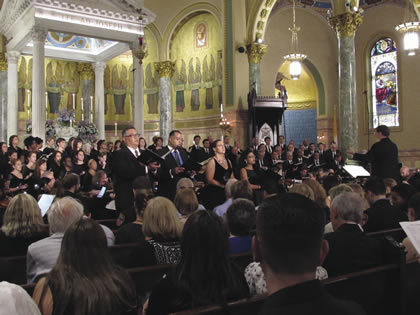 View full size
EIRNS/Sylvia Rosas
The Schiller Institute Chorus performing Mozart’s Requiem in the Mass at St.Joseph’s Co-Cathedral in Brooklyn, New York on Sept. 11, 2016. Soloists, left to right: Jay Baylon (bass-baritone), Everett Suttle (tenor), Mary Phillips (mezzo-soprano), and Indira Mahajan (soprano). |
The Schiller Institute’s New York City Community Chorus was the vocal core of the concerts, which also featured soloists Indira Mahajan (soprano), Mary Phillips (mezzo-soprano), Everett Suttle (tenor) and Phillip Cutlip (bass-baritone). Soloist Jay Baylon replaced Cutlip in the Sunday Mass at St. Joseph’s Co-Cathedral. The Foundation for the Revival of Classical Culture, which sponsored the performances, has since 2012 correctly insisted that performances of the Classical repertoire should occur at the “Verdi Pitch,” or what the Foundation’s originator and head, Lynn J. Yen, calls “the proper tuning”—a Middle C equal to 256 cycles per second (C-256).
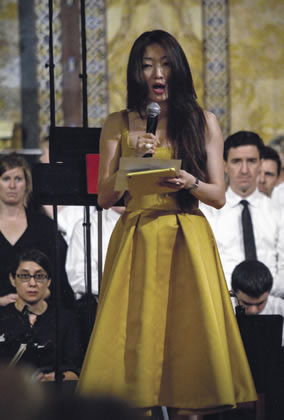
EIRNS/Pavel Penov
Lynn Yen, founder and head of the Foundation for the Revival of Classical Culture speaks at the Sept. 10, 2016 performance in Manhattan, New York. The Foundation sponsored the four performances. |
About this matter, the Brooklyn Reporter online newspaper said: “The Foundation for the Revival of Classical Culture presented a special performance of Mozart’s Requiem, a piece rarely performed during a Mass, according to the Diocese.” It continued,
The Schiller Institute NYC Community Chorus, accompanied by a 42-piece orchestra and guest soloists, performed the Requiem at the ‘Verdi tuning. . . .’
‘Proper Verdi tuning allows for the most transparent blend of the human voice with the instruments, and thus, maximum sonority,’ said Lynn Yen, the executive director of the Foundation for the Revival of Classical Culture. ‘To hear the Mozart Requiem at this pitch is to experience the transcendent power of sacred music—to experience the true glory of God and music.’
Diane Sare, co-founder of the chorus with John Sigerson, who conducted the four Requiem performances, had created the New York Community Chorus—originally a group that was to be based in New Jersey—as a “first response” to the “choke-hold” killing of Eric Garner in Staten Island in the Summer of 2014, and the killing of two policemen in Brooklyn in December of that same year. (The policemen were in fact killed during the chorus’ first “maiden voyage” concert, performing selections from Handel’s Messiah with instrumental accompaniment. When the singers finished, they were told what had happened while they were singing, and, shocked, fully committed themselves to the project.)
The problem Sare recognized, as a former Congressional candidate and longtime associate of EIR founder Lyndon LaRouche as well as a musician, was that political protest, or backlash against political protest, was worse than useless in the aftermath of the cultural despair that has descended upon the United States over the past fifteen years of Bush and Obama presidencies.
It was LaRouche who had raised the idea of a “Living Memorial” in the course of one of his weekly Manhattan dialogues, in responding to a veteran’s question concerning how such commemorations might occur. Months prior, Sigerson had proposed, “if it were possible,” that a Mozart Requiem performance might be done somewhere in the City. The “Living Memorial” idea was further concretized by the “discovery” by an individual visiting New York City, of a 100-foot-tall monument, called the “Tear Drop Memorial,” dedicated by the people of Russia, and personally by Vladimir Putin in 2005, to the United States, its people, and the struggle against world terrorism.
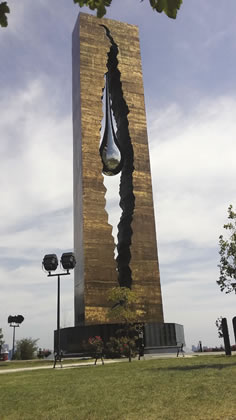 View full size
EIRNS/Karen Nafziger |
The “Teardrop Memorial” presented to the United States by Russia and President Putin, as a memorial to the victims of the Sept. 11, 2001 attacks. |
The monument was “hiding in plain sight,” directly across from the site of the World Trade Center’s destruction, in Bayonne, New Jersey, and virtually never acknowledged. Former Speaker of the New Jersey Assembly Joseph Doria, the mayor of Bayonne at the time that the monument was first dedicated, said, “People have asked me why it was built by the Russians. And I explain: The Russians wanted the United States citizens to know that the entire world cried after 9/11 to see the desecration, and this slaughter of innocents for no purpose at all.”
It was determined by the Foundation for the Revival of Classical Culture, including students that had just participated in a five-week long Summer-school, as well as parents, teachers, and members of service organizations, that everything would be done to allow everyone that wished to attend these concerts in New York City to do so, to be given that opportunity. The disquisition on the subject of immortality that is the dying Mozart’s Requiem, would be presented in not one, but four performances, complete with a 42-piece orchestra and a chorus which at its smallest was 80 persons, and at its largest was 170.
The daunting Responsibility that would confront the ensemble in these four days, was that the performances would require the quality of the Sublime. An amateur chorus, coupled with a professional orchestra, soloists, and conductor, would have to deliver an effect not merely “credible” to the hearers, but one that would be life-changing. Life had, after all, on Sept. 11, 2001, been changed for millions forever that day, murderously. Was there a way to use music, for those that participated, either by listening, or performing, to defy “the triumph of the grave”?
Friedrich Schiller and 9/11
Friedrich Schiller’s essay, “On The Sublime,” contains this passage:
All nature acts according to reason; (man’s) prerogative is merely, that he act according to reason with consciousness and will. All other things must; man is the being, who wills.
Precisely for this reason is (there) nothing so unworthy of man as to suffer violence, for violence annuls him. Who does it to us, disputes nothing less than our humanity; who suffers it in a cowardly manner, throws away his humanity.

EIRNS/Stuart Lewis
Firefighters of Battalion 57 of the New York Fire Department carried 23 flags to the mass at St. Joseph’s Co-Cathedral on Sept. 11, 2016, in commemoration of the 23 firefighters from the Battalion who died on Sept. 11, 2001. |
Schiller goes on to say that the highest expression of the human will, is that case in which a man or woman willfully suffers violence in favor of preserving and advancing the idea of humanity as a whole. “To annihilate violence as a concept, however, is called nothing other than to voluntarily subject oneself to the same.” In fact, that higher ideal of humanity was exactly what was upheld by many of the first responders—firemen, policemen, medical personnel, and volunteers—on that horrific day of 9/11.
For several reasons, the Mozart Requiem presented at St. Joseph’s Co-Cathedral in Brooklyn was a particularly unique moment in American history, and not merely in music. The Requiem was performed as part of a full Catholic Mass, probably the first of its kind in the United States since January 1964, when a similar ceremony was conducted in honor of the slain John F. Kennedy at the request of his wife, Jacqueline, at Boston’s Cathedral of the Holy Cross. The difference from even that occasion, though, was that this Sept. 11, though the Requiem was to be performed, the Mass was not itself a “requiem Mass ,” because such a Mass cannot be performed on a Sunday, the day of Christ’s resurrection in the Christian faith. Sunday cannot be a liturgical “day of death,” but must needs be a day of affirmation of life. The “Gloria” from the Mozart Mass in D Minor, K. 65, was therefore added. That Mass also concluded with “Worthy Is The Lamb That Was Slain/Amen,” the end of Handel’s Messiah, employed as the dismissal hymn.
This annual Brooklyn ceremony is dedicated to and attended by the firefighters of Battalion 57 of the Fire Department of New York, 23 of whose members had given their lives for their country on Sept. 11, 2001. Hundreds of firefighters attended. The Tablet, the diocesan newspaper, reported:
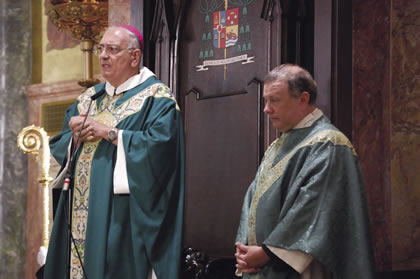
EIRNS/Stuart Lewis
Bishop Nicholas DiMarzio (left) and Msgr. Kieran Harrington celebrated the Sept. 11, 2016 mass at St. Joseph’s Co-Cathedral. |
Prior to the Mass, members of the Battalion, which includes five engine companies and one ladder company in Brooklyn, marched from Ground Zero in Manhattan, over the Brooklyn Bridge, to St. Joseph’s Co-Cathedral, making stops at several firehouses along the way. They carried FDNY [New York Fire Department] flags, one for each of their fallen members. For the firefighters, the journey to Brooklyn served to symbolize the return home of their fallen comrades, said Firefighter Thomas Callahan, who delivered opening remarks at the church.
Bishop Nicholas DiMarzio and Msgr. Kieran Harrington concelebrated the Mass, attended by 1100-1200 people. Bishop DiMarzio’s homily was remarkable for its direct emphasis on the idea of forgiveness. He pointed out that the firefighter fulfills not only the New Testament admonition, “Greater love than this, no man hath, that a man lay down his life for his friends.” The firefighter does this for strangers, and even, sometimes, his enemies, and he does that every day, as a vocation. The inclusion of the Requiem as part of the celebration of the Sunday Mass for Sept. 11 was suggested by Msgr. Harrington.
African-American Spirituals and 9/11
Diane Sare and her chorus are becoming leading defenders of the African-American Spiritual in the United States. Sare is privileged to have known and worked with the great Sylvia Olden Lee for about a decade. She also knows several of the late Ms. Lee’s collaborators, such as mezzo-soprano Elvira Green, tenor and choral master Gregory Hopkins, the late William Warfield, and several others.
Increasingly, in many performances of Classical music in today’s United States, the Spiritual should be performed, but only by competent choirs. The reason is that Americans can no longer hear, and usually confuse music with noise, electronic and non-electronic. The African-American Spiritual can provide a welcome antidote to that problem.
The words of the Spirituals are simple, but their meaning is not. The audience, hearing the least words possible, but with the historical drama of the triumph over slavery in America’s 1861-65 conflict as an implicit backdrop, is taken beyond its “entertainment zone,” its “comfort zone,” and placed on the stage of the tragedy. It is the hard fought-for humanity present in that tragedy that is the province of those songs—not the songs of slaves, but of those that would be free even at the price of death. In this way, Americans are also given a gateway to what the intent was, for example, behind the operas of Giuseppe Verdi, or in this instance, the Mozart Requiem. Sare’s chorus performed “Deep River,” ” When I was Sinkin’ Down,” “My Lord, What A Morning,” and “Soon Ah Will Be Done,” without accompaniment. The significance of the C=256 tuning was heard in the transparency of the voices relative to that of other choruses, which allows for the “inner voices” to be clearly heard without distortion.
The choral prelude was prerequisite to establishing an audience concentration-span, and audience “listening standard,” before a note of Mozart were sung. This was particularly noticeable in the Saturday, Sept. 10 performance at St. Bartholomew’s Church on Park Avenue (Spirituals were not performed as part of the Sunday ceremony).
Soprano and vocal coach Carmela Altamura, who was unable to attend the concerts, made the following comment about about the “Living Memorial idea”:
Through music, and through the arts, and through the beauty and the harmony of the arts, man can easily reveal himself to his true Self. Man can find this through the arts, which are not always beautiful. This is also a part of man. Music has cacophony, it can have dissonance; that, too, is a revelation of the Self. In order to have harmony, you must recognize the difference between harmony and dissonance—the two go together, so man can choose.
The horror of 9/11 is part of the dissonance, part of the darkness of man. We can also get to understand our darkness. It can reveal itself to us. There are some thoughts and emotions that man will not even want to reveal. Better to confront them and not push them aside, because only by recognizing them can we choose—do we have the freedom of choosing.
The arts also bring us to this realization. So man, through the arts, can turn towards freedom, can turn towards the light, which elevates his soul to the highest achievement of a destiny of development—the highest level of expression.
Terry Strada, the head of “9/11 Families and Survivors United for Justice Against Terrorism,” welcomed the ensemble and audience to the Morristown concert. Strada, who played the role of “unofficial Congressman” in the unanimous passage of the Justice Against the Sponsors of Terrorism Act (JASTA) by the House of Representatives and the Senate, wanted it to be known that it was possible to fight and win justice. She also said, “I thank you very much for taking the time to listen to me, and now I’m so honored to have these wonderful musicians. I have heard them practice. You are in for a treat. This is going to be a very wonderful time now for us to just transcend ourselves from the evil, to a higher place—to a place where Good is. I believe Good will win, and I thank you for coming.” [applause]
‘The Power of the Beautiful’
 View full size EIRNS/Torrie Hall
Terry Strada, the head of “9/11 Families and Survivors United for Justice Against Terrorism,” spoke at the Schiller Institute performance at the Presbyterian Church in Morristown, N.J., Sept. 12, 2016. |
More than 100 people indicated their willingness to become members of the Schiller Institute Chorus, by the end of the four-day period. The Foundation for the Revival of Classical Culture received many favorable comments transmitted to their website. Student volunteers of the Foundation, who had distributed leaflets and concert announcements every day for a ten-day period at Lincoln Center, also reported that many youth, as young as twelve and thirteen, were actively discussing how to form a youth chorus in the Bronx. There, state legislator José Rivera, who had been, together with several other prominent figures in the Bronx, involved on the ground floor in encouraging the inclusion of the Bronx in this work, was in attendance. He remarked that, although people might think that he “was only listening to Salsa,” things are a lot different than they might seem.
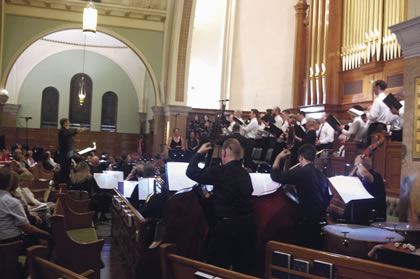 View full size
EIRNS/Torrie Hall
The Schiller Institute Chorus performance of Mozart’s Requiem at the Presbyterian Church in Morristown, N.J. |
People, as poet Friedrich Schiller once wrote, “are born for that which is better.” The concert program essay, “The Power of the Beautiful,” concluded:
The struggle of the human being to become better, to discover his/her purpose in the universe, the struggle to make life matter, does not require violence; it requires the abolition of violence. It requires the willful and deliberate rejection of beast-like reactive emotions largely based in fear and rage, and the conscious acceptance of the responsibility to ‘institute government among men,’ established to nurture that creative human identity that is the birthright of all people, for all time. Classical music’s greatest composers create, utilizing various forms—string quartets, symphonies, and solo works—new discoveries in time, new human forms of nature, new realizations whose physical power to change the world by provoking the human mind to lift itself ‘above the heavens,’ can change the very destiny of the universe itself. In the works of the greatest composers, we can hear, experience and partake in that inner self-advancement, to express and communicate more and more perfectly the truth of that which is all around us: Life is simultaneously a gift, and the very force of the universe itself. It is free, but necessary; it is unique, but infinitely reproducible; it is limited in the individual, but limitless in the species. Life is beautiful, and bountiful.
That is the song of the future that we hear in the Requiem of Wolfgang Amadeus Mozart. That is the means whereby the crime of September 11, 2001, and its even more horrific ongoing consequences can be expiated from the world. There was a reason that the walls of Jericho ‘came a tumblin’ down,’ and it was not the superior force of arms, but of voices—the voices of those who, through Beauty, had proceeded to free their souls, and therefore their nation. So shall it be with us.
